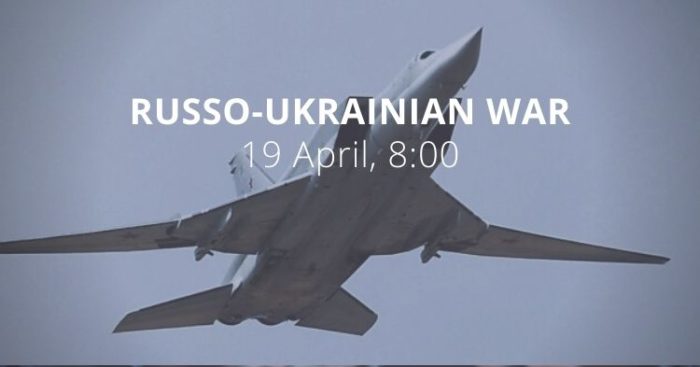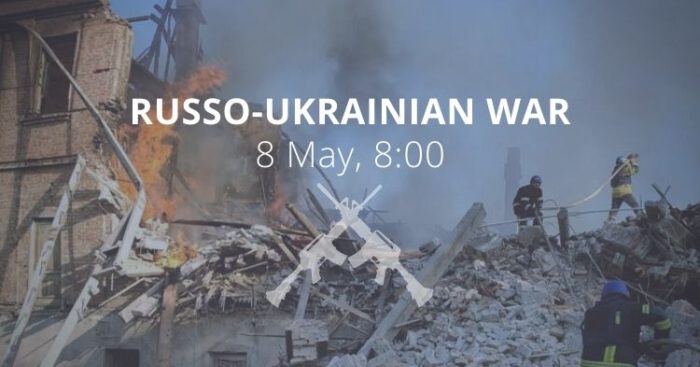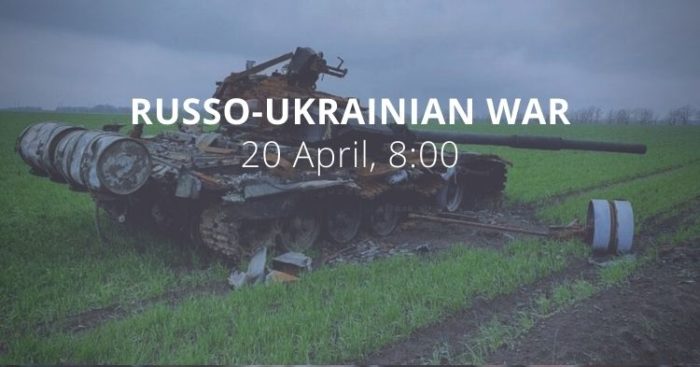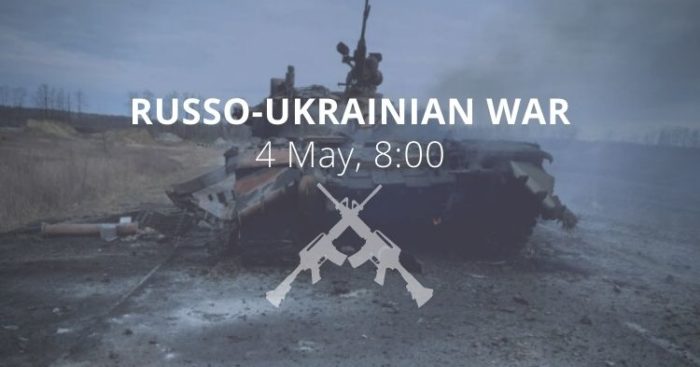Situation
According to information from the General Staff: Russian forces launch air and missile strikes and artillery shelling of civilian and military infrastructure in the depths of Ukraine, the positions of our troops along the line of contact and in the border areas. It is regrouping and strengthening of occupying forces continues.
In the Volyn and Polissya directions, Russian forces did not take active action. There have been no significant changes in the situation in these areas.
Russian forces launch air and missile strikes and artillery shelling of civilian and military infrastructure in the depths of Ukraine, the positions of our troops along the line of contact and in the border areas. It is regrouping and strengthening of occupying forces continues.
In the Volyn and Polissya directions, Russian forces did not take active action. There have been no significant changes in the situation in these areas.
- Certain units of the Armed Forces of the Republic of Belarus continue to carry out tasks to strengthen the section of the Ukrainian-Belarusian border in the Brest and Gomel oblasts. An inspection of the readiness of the aviation component of the regular forces and means of the air defense system of the Republic of Belarus was noted.
- The threat of missile and bomb strikes on the objects of Ukraine from the territory of the Republic of Belarus remains.
- Russian forces, by keeping the appropriate set of troops, are trying to prevent the movement of reserves of the Armed Forces of Ukraine from the Siversky direction to the Eastern Operational Zone. In the areas of the Bryansk and Kursk oblasts bordering Ukraine, Russian forces deployed part of the units to restore combat capability.
- In the future, it is possible that the forces will demonstrate and provoke in the areas adjacent to the state border of Ukraine. In particular, there is a possibility of shelling of units of the Defense Forces of Ukraine and infrastructure in the border areas.
- Russian units tried to launch an offensive in the direction of the settlements of Sulyhivka and Dovhenke but were unsuccessful. In order to cover the groups of its troops in the Kharkiv and Izium directions, Russian forces are trying to deploy forces and means of air defense.
- Russian forces group of the 6th Combined Arms Army, the coastal troops of the Baltic and Northern Fleets are focusing on maintaining positions in the area north and southeast of Kharkiv, trying to deploy additional artillery units.
- In the Izium direction, Russian forces are operating with units of the 1st Tank Army, the 20th Combined Arms Army of the Western Military District, the 35th Combined Arms Army, the 68th Army Corps of the Eastern Military District, and the Airborne Troops. The Russian forces’ main efforts are focused on conducting reconnaissance and inflicting fire damage on units of the Armed Forces of Ukraine.
- To ensure additional transfer of troops in the Izium direction, Russian occupiers provide additional pontoon-bridge crossings across the Siversky Donets River.
- Artillery shelling of units of Ukrainian troops does not stop in the Zaporizhzhia direction.
- Fourteen forces attacks were repulsed in Donetsk and Luhansk oblasts over the past 24 hours, eleven tanks, seven artillery systems, twenty-eight armored vehicles and fourteen vehicles were destroyed.
- In the Donetsk and Tavriya directions, forces units are trying to launch an offensive in the Lyman, Sievierodonetsk, and Popasna directions. Russian forces continue to try to establish full control over the settlements of Rubizhne and Popasna and are preparing to advance on Sievierodonetsk. Russian forces continue artillery shelling our troops.
- In the Kurakhiv direction, the occupiers' groups were reinforced by additional artillery units from the 1st Army Corps.
- In the Mariupol direction, Russian forces continued to launch airstrikes on Mariupol. It focused its main efforts on blocking the units of Ukrainian troops in the area of the Azovstal plant, and also transferred some units from the Mariupol to the Kurakhiv direction.
Russia’s ongoing forced conscription in Ukraine’s Donbas leads to de-facto elimination oc local male population, as occupiers use them as “cannon fodder." Moreover, Russia is unfolding a forcible mobilization in just-occupied territories of S-NE Ukrainehttps://t.co/nu3q5rXc73
— Euromaidan Press (@EuromaidanPress) April 28, 2022
- In the Bessarabian direction, there are without significant changes.
- In the Mykolayiv direction, Russian forces intensified air reconnaissance in the operational depth of the defensive positions of the Armed Forces of Ukraine, presumably in order to expose the presence and nature of the actions of the reserves.
- In the Transnistria of the Republic of Moldova, the Russian Federation continues to disseminate information through pro-kremlin media about the threat to the population of the region from Ukraine. In particular, there are reports of another case of Ukrainian UAVs being used over ammunition depots.
- Russia hopes to rectify issues that have previously constrained its invasion by geographically concentrating combat power, shortening supply lines, and simplifying command and control.
- Russia still faces considerable challenges. It has been forced to merge and redeploy depleted and disparate units from the failed advances in northeast Ukraine. Many of these units are likely suffering from weakened morale.
- Shortcomings in Russian tactical coordination remain. A lack of unit-level skills and inconsistent air support have left Russia unable to fully leverage its combat mass, despite localised improvements.
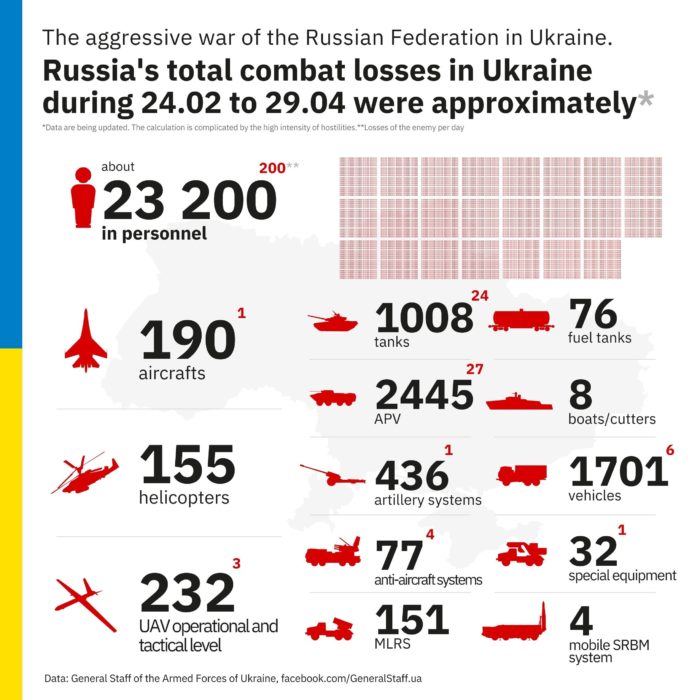
- Personnel – more than 23200 people (+200),
- Tanks – 1008 units (+22),
- Armored combat vehicles – 2445 units (+27),
- Artillery systems – 436 (+1),
- Multiple rocket launchers – 151 (+0)
- Air defense means – 77 (+4),
- Aircraft - 190 (+1),
- Helicopters - 155 (+0),
- Automotive technology – 1701 (+6),
- Vessels/boats - 8 units (+0),
- Fuel and lubricant tanks – 76 (+0),
- UAV operational and tactical level – 232 (+3)
- Special equipment – 32 (+1)
- Mobile SRBM system – 4 (+0)
Humanitarian
According to the Deputy Prime Minister and Minister of Reintegration of Temporarily Occupied Territories of Ukraine as of April 28, as a result of the meeting between the President of Ukraine and the UN Secretary-General: “There is a hope for evacuation of civilians from Azovstal. We start to plan the humanitarian operation. This is one of our top priorities”. According to UNHCR 5,429,739 refugees have been registered as of April 28. The UN says that so far Poland has taken in 2,992,575 refugees, Romania 810,021, Russian Federation 656,381, Hungary 513,848, Republic of Moldova 441,437, Slovakia 367,904 and Belarus 25,002. Among those who fled Ukraine are also Ukrainian nationals with dual citizenship. An additional 105,000 people moved to the Russian Federation from the Donetsk and Luhansk oblasts between 18 and 23 February. The number of Ukrainians entering Ukraine since February 28 is 1,257,500 as of April 28. This figure reflects cross-border movements, which can be pendular, and does not necessarily indicate sustainable returns. https://twitter.com/EuromaidanPress/status/1520225172829073408?s=20&t=WoNfSkqjwG740f4qr7fD3A OHCHR recorded 6,134 civilian casualties in Ukraine as of April 27. 2,899 were killed (including 210 children) and 3,235 injured (including 309 children).Environmental
I chose to interpret the term “environmental” broadly. The ongoing information war is exploiting one of the most crucial environments in this war: the cognitive space. The main battlespace of the hybrid war occurs inside the cognitive spaces of populations and key decision- and policymakers, making them, and not the military, the main target of the operation. The population is the center of gravity. The strategy exploits the protest potential of the population of both the nation under assault and that of its partner nations. It manipulates and reinforces existing vulnerabilities trying to ignite social instability. It aims to destabilize the nation from within by inducing economic hardship, corruption, undermining trust in government, politicians, institutions, and democratic processes, and not at least, creating fear and fostering inaction. Threats have become an increasingly predominant factor, including the threat of the war spreading (which it already has) and World War 3. According to the Ukraine World, this includes some of the following false narratives: “Since the beginning of Russia's full-scale invasion of Ukraine, the topic of World War III has been actively circulating in the Russian media. First of all, according to Russian media, talks of World War III are "a standard method of intimidation" and "a fairly popular topic for Western speculation." Although before April, there were some articles in the Russian media denying World War III, from the beginning of April, Russian propaganda shifted to another narrative: World War III is being provoked by the West and Ukraine, and Russia only "prevents" such a course of action. So RIA Novosti published an article, "Western society is being prepared for the Third World War," in which propagandists assure that "Western inhabitants are being forced to conclude that a world war is not only inevitable but that it is already underway." In the article, propagandists examine in detail the "examples" of the actions of some European and American politicians, which, in their opinion, "push to scenarios that are guaranteed to lead to a direct military clash between NATO and Russia, and hence to a possible world war." They also recall "the idea of the Polish government to introduce a NATO peacekeeping contingent into Ukraine, which again is guaranteed to lead to the start of a global conflict." Moreover, propagandists accuse the authors of an American newspaper of "irresponsibility in raising hatred of Russia." The press secretary for the Russian president Dmitry Peskov called "the prevention of World War III as a goal of the operation in Ukraine" on the air of the British television channel Sky News."Imagine a situation where a NATO member, Ukraine, thinking about the return of Crimea, attacks Russia and Russian Crimea. Applying Article 5 of the NATO Charter, NATO countries with nuclear weapons will have to defend Ukraine. There could be a third world war. What is being carried out now is protecting us from any potential threat of such a war," Dmitry Peskov said.Russian media even used comments from Ukrainian political scientist Kost Bondarenko in an interview with political scientist Ruslan Bortnik, but both figures are known for their pro-Russian views and ties to the Opposition Platform—For Life and Party of Regions. Thus it is not surprising that the statement of a "Ukrainian political scientist" that "the military operation in Ukraine is not a component of the Third World War, it prevents it" confirmed Russian narratives. Over the past two weeks, Russian propaganda has begun to state the possible beginning of World War III and even suggest why it could start. The high probability of World War III was stated by the propagandist Margarita Simonyan in the program of Vladimir Solovyov.
"Either we lose in Ukraine, or World War III begins. I think World War III is more realistic, knowing us, knowing our leader. The most incredible result that this will end in a nuclear strike seems more likely to me than any other scenario," said Margarita Simonyan.According to Russian media, anti-Russian sanctions may be one of the causes of World War III. For instance, propagandists refer to the article by retired French general Jacques Guilleman on the Entre La Plume et l'Enclume website. In the article, he noted that if the US and Europe do not stop their anti-Russian sanctions, the Third World War will be inevitable.»
Legal
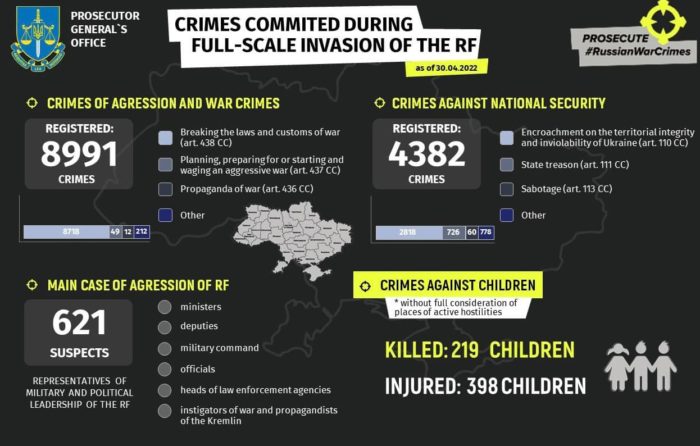 219 children were killed, and 398 children injured, the Office of the Prosecutor General of Ukraine reports as of 30 April. 1,570 educational establishments are damaged as a result of shelling and bombings, 111 of them are destroyed fully. 8,991 crimes of aggression and war crimes and 4,382 crimes against national security were registered.
219 children were killed, and 398 children injured, the Office of the Prosecutor General of Ukraine reports as of 30 April. 1,570 educational establishments are damaged as a result of shelling and bombings, 111 of them are destroyed fully. 8,991 crimes of aggression and war crimes and 4,382 crimes against national security were registered.
Media and experts documented 178 cases of rape of Ukrainians by Russian soldiers. But it could be just the tip of the iceberg, and the actual number of rapes is much higher https://t.co/Zsy7ugUmOM
— Euromaidan Press (@EuromaidanPress) April 29, 2022
Support
Poland handed over more than 200 tanks to Ukraine, Ukrainska Pravda reports citing Polish Radio. Poland has supplied Ukraine with more than 200 T-72 tanks and several dozen infantry fighting vehicles. Poland is primarily handing over to Ukraine tanks that have not been modernized. According to Polish Radio, in addition, Poland has already delivered to Ukraine 2C1 self-propelled howitzers "Carnation", "Grad" MLRS, air-to-air missiles for MiG-29 and Su-27 aircraft, Polish drones made by WB Electronics, Warmate drones, portable anti-aircraft missile systems and "a large amount of ammunition". Germany considers sending howitzers to Ukraine, the Reuters reports.“Germany is considering sending long-ranged howitzers to Ukraine, a security source told Reuters on Friday, confirming a report published by Welt am Sonntag newspaper only days after Berlin first decided to supply heavy weapons to Kyiv. Berlin is in talks with the Dutch government on delivering the Panzerhaubitze 2000 to Ukraine, the source said, referring to one of the most powerful artillery weapons in the Bundeswehr inventories that can hit targets at a distance of 40 km (25 miles). The move follows warnings by the Kremlin that Western arms supplies to Ukraine posed a threat to the security of the European continent and provoke instability"Ukrainian military gets S-300 missile system from partner countries, the Ukrinform reports. Anti-aircraft missile forces of the Air Command South of the Ukrainian Armed Forces have received an S-300 missile system from partner countries, which significantly strengthened Ukrainian air defenses in the south of the country, according to the Command of the Ukrainian Air Force statement on Telegram. "The S-300 missile system effectively performs its work against a significant part of the objects of the Russian occupiers and can shoot down aircraft, cruise and ballistic missiles at a distance of 5 to 150 kilometers. At the same time, it doesn't matter at what height the target flies - 10 meters or 27 kilometers," the statement reads. The system is already performing combat missions. Slovenia to send additional material aid to Ukraine, the Slovenia Times reports.
“Under a government decision taken at Friday’s correspondence session, Slovenia will send Ukraine material assistance in the form of IP phones, computers, petrol generators, antennas and cables, the Defense Ministry said. The estimated value of the aid, including transport, is nearly EUR 180,000. The ministry is in charge of the project that will be carried out through the EU Civil Protection Mechanism. The aid includes 100 IP phones, 40 desktop computers and 60 laptops.”Ukraine calls on the world to help clear its territory of explosives, the Ukrainska Pravda reports. Denys Monastyrskyi, Minister for Internal Affairs of Ukraine, has called on the world’s countries and international organizations to help clear those territories of Ukraine that have been the site of active hostilities of explosives by sending personnel and equipment.
"1 day of hostilities equals 30 days of clearing away explosives. For example, fighting in Kyiv Region lasted for 30-35 days. Multiply this by 30 and you get the number of days it would take the State Emergency Service to clear away explosives from those territories approximately 1,5 years.”Norway shuts borders, ports to Russian goods exempt fishing vessels, the Reuters reports.
“Norway will close its borders and ports to Russian trucks and ships, joining sanctions imposed by the European Union over the war in Ukraine, the Norwegian foreign ministry said on Friday. Russian fishing vessels, which often land their catch at ports in northern Norway, will receive exemptions from sanctions in line with the EU sanctions regime, which exempts vessels carrying pharmaceutical, medical, agricultural and food products. Norway's Arctic Svalbard archipelago, which operates under a 1920s treaty allowing expanded foreign access, will also be exempted, the ministry said.”Ukraine receives EUR 88.5M in grant aid from World Bank, the Ukrinform reports. On April 29, 2022, Ukraine received EUR 88.5 million in grant aid from the World Bank’s Donor Trust Fund. The relevant statement was made by the Ukrainian Finance Ministry. “Today Ukraine’s state budget general fund has received a grant of EUR 88.5 million. These funds were provided by the World Bank on a non-repayable basis from the Donor Trust Fund under the Second Economic Recovery Development Policy Program for Ukraine,” the report states. According to the ministry, these funds will be used to ensure priority social, humanitarian, healthcare expenditures and support for internally displaced persons.
New developments
- The Ukrainian Presidential Office says this is not the time for a meeting between Zelenskyy and Putin, the Ukrainska Pravda reports. Mykhailo Podoliak, an adviser to the head of the President's Office, believes that President Zelenskyy and President Putin will meet later, but "this is not the time" for them to talk. We want Ukraine's position in these negotiations to be very, very strong. He said that "the negotiation process is slower" because of the war crimes that have come to light, and because of the Russian attempt to strengthen their position.
- Ukraine asks partners to decide on security guarantees for the country, the Ukrinform reports. Ukraine asks international partners to decide which security guarantees they are ready to provide to our country in case of any aggression in the future. “Ukraine gave up nuclear weapons for the sake of world peace. We have then been knocking on NATO’s door, but it never opened. The security vacuum led to Russian aggression. The world owes Ukraine security and we ask states to decide which security guarantees they are ready to provide,” Minister of Foreign Affairs of Ukraine Dmytro Kuleba posted on Twitter.
- Russian operation in Ukraine contributes to “freeing the world from Western oppression”, the TASS reports. Russia's so-called special military operation in Ukraine is contributing to allegedly liberating the world from Western neocolonial oppression, Russian Foreign Minister Sergey Lavrov claimed in an interview with the Xinhua news agency. "It is obvious that the collective West’s attempts to hinder the natural course of history, to solve its problems at the expense of others are doomed," the minister said.
- 8,000 British troops will join allied exercises in Europe, officials say, The New York Times reports. The British military will send some 8,000 troops to Europe as part of a larger allied deployment to deter further Russian aggression, British officials said. The British troops will be serving in the Joint Expeditionary Force, a British-led multinational group created in 2014 in response to Russia’s seizure of Crimea from Ukraine. Tens of thousands of troops from Joint Expeditionary Force and NATO countries will participate in exercises between April and June, Britain’s defense ministry said in a statement released on Friday.
Assessment
On the War The Institute for the Study of War has made the following assessment as of Friday 29 April:Key TakeawaysConcert "Life will win" took place in Dnipro metro
— Euromaidan Press (@EuromaidanPress) April 30, 2022
Musicians of the bands VV, Pianoboy, and comedians of Kvartal 95 performed underground to lift the spirits of city residents and those displaced from the war zonehttps://t.co/BvRXrto1Pw pic.twitter.com/JiO6bfXcV1
- Russian forces likely intend to leave a minimal force in Mariupol necessary to block Ukrainian positions in Azovstal and prevent partisan actions and are deploying as much combat power as possible to support offensive operations elsewhere.
- Ukrainian forces are successfully slowing Russian attacks in eastern Ukraine, which secured only minor advances west of Sievierodonetsk and did not advance on the Izium front in the last 24 hours.
- Ukrainian counterattacks in Kharkiv are unlikely to develop into a major counteroffensive in the coming days but may force Russia to redeploy forces intended for the Izium axis to hold their defensive positions around the city.
- Ukrainian intelligence continued to warn that Russian false flag attacks in Transnistria are intended to draw Transnistria into the war in some capacity and coerce Moldova to abandon pro-European policies.“


